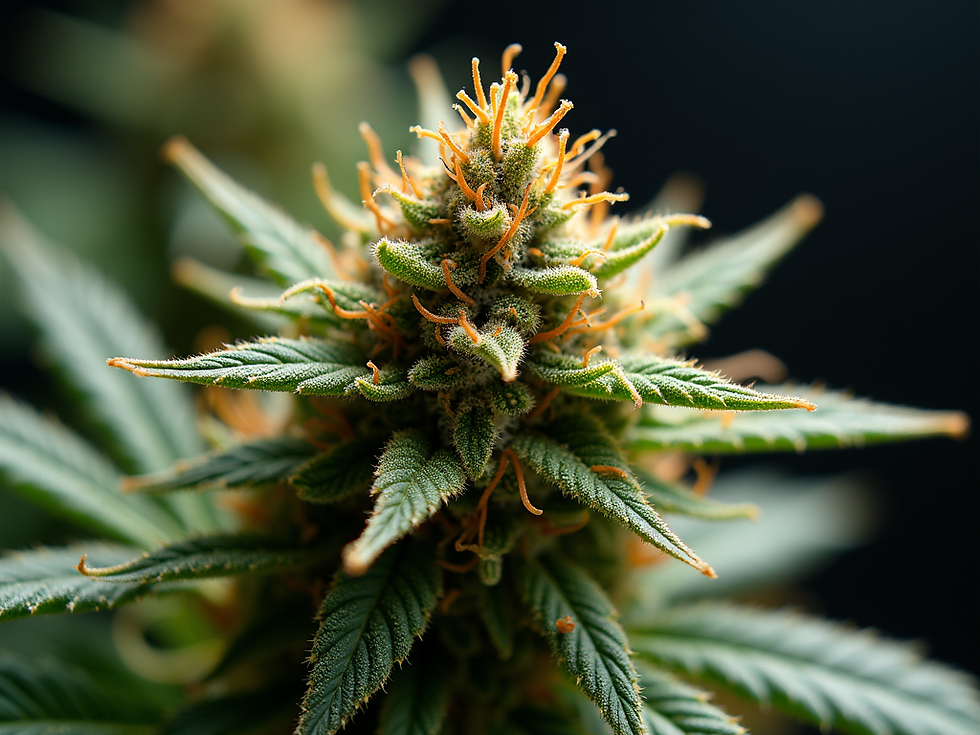Key Differences Between THCA and THC Explained
- Smoke Central Hemp

- Sep 26
- 4 min read
Understanding the differences between THCA and THC is essential for anyone interested in cannabis products. These two compounds are closely related but have distinct properties and effects. This article will break down the key differences, how they affect the body, and what you need to know when choosing cannabis products.
What Are THCA and THC?
THCA (tetrahydrocannabinolic acid) and THC (tetrahydrocannabinol) are cannabinoids found in the cannabis plant. THCA is the raw, non-psychoactive precursor to THC. When cannabis is fresh and unheated, it contains mostly THCA. THC is produced when THCA undergoes decarboxylation, a process triggered by heat, such as smoking, vaping, or cooking.
THCA itself does not cause the "high" associated with cannabis. Instead, it offers potential therapeutic benefits without psychoactive effects. THC, on the other hand, is the compound responsible for the euphoric and mind-altering effects.
How THCA Converts to THC
The conversion from THCA to THC happens through decarboxylation. This process removes a carboxyl group from THCA, turning it into THC. Decarboxylation occurs naturally over time or rapidly when exposed to heat.
Raw cannabis: High in THCA, low in THC
Heated cannabis: THCA converts to THC, producing psychoactive effects
This transformation is why raw cannabis does not get you high, but smoking or cooking it does.

Close-up view of cannabis flower showing trichomes
Understanding THCA vs THC effects
The effects of THCA and THC differ significantly due to their chemical structure and interaction with the body's endocannabinoid system.
THCA Effects
Non-psychoactive: THCA does not bind strongly to CB1 receptors in the brain, so it does not produce a high.
Potential health benefits: Research suggests THCA may have anti-inflammatory, neuroprotective, antiemetic (anti-nausea), and anti-proliferative properties.
Raw consumption: THCA is often consumed in raw cannabis juice, tinctures, or capsules to avoid decarboxylation.
THC Effects
Psychoactive: THC binds to CB1 receptors, causing the classic cannabis high.
Therapeutic uses: THC is used for pain relief, appetite stimulation, anxiety reduction, and more.
Side effects: Can include dry mouth, red eyes, increased heart rate, and anxiety in some users.
Because of these differences, users seeking medicinal benefits without intoxication may prefer THCA-rich products, while those looking for recreational or psychoactive effects will choose THC-dominant products.

Eye-level view of cannabis oil in a dropper bottle
Is 30% THCA the same as 30% THC?
This is a common question among cannabis consumers and growers. The short answer is no, 30% THCA is not the same as 30% THC in terms of effects or potency.
Why They Are Different
Potency: THCA is not psychoactive, so 30% THCA does not produce the same high as 30% THC.
Conversion factor: When THCA converts to THC, it loses some mass due to the removal of the carboxyl group. This means 30% THCA will yield roughly 87.7% of that amount in THC after decarboxylation.
Labeling: Some cannabis products list THCA content separately from THC. To estimate potential THC after decarboxylation, multiply THCA percentage by 0.877 and add any existing THC.
Practical Example
If a cannabis flower contains 30% THCA and 2% THC:
Potential THC = (30% × 0.877) + 2% = 26.31% + 2% = 28.31% THC after decarboxylation
This means the actual psychoactive potency is slightly less than the THCA percentage alone suggests.
Understanding this helps consumers make informed decisions about product strength and expected effects.

High angle view of cannabis buds on a wooden table
How to Choose Between THCA and THC Products
Choosing the right product depends on your goals and preferences. Here are some tips to help you decide:
For Non-Psychoactive Benefits
Look for THCA-rich products like raw cannabis juice, tinctures, or capsules.
Avoid heating the product to preserve THCA.
Ideal for those seeking anti-inflammatory or neuroprotective effects without a high.
For Psychoactive Effects
Choose products with higher THC content.
Smoking, vaping, or cooking will activate THC.
Suitable for recreational use or medical conditions benefiting from THC’s effects.
Consider Product Labels Carefully
Check if the product lists THCA and THC separately.
Use the conversion factor to estimate total THC potential.
Ask dispensary staff for guidance if unsure.
Storage and Handling
Store cannabis in a cool, dark place to slow THCA conversion.
Avoid prolonged exposure to heat or light.
Future Research and Developments
The cannabis industry is rapidly evolving, and research into cannabinoids like THCA is expanding. Scientists are exploring:
Medical applications: THCA’s potential in treating epilepsy, inflammation, and neurodegenerative diseases.
New product formulations: THCA isolates, raw cannabis extracts, and non-psychoactive supplements.
Consumer education: Helping users understand cannabinoid profiles and effects.
As knowledge grows, consumers will have more options tailored to their needs, whether for wellness or recreation.
For a detailed comparison and more information on the differences between these cannabinoids, check out this resource on thca vs thc.
Understanding the distinctions between THCA and THC empowers you to make better choices and enjoy cannabis products safely and effectively.



